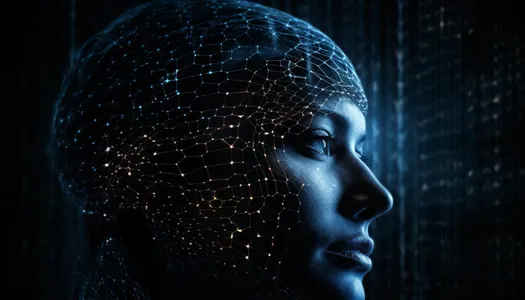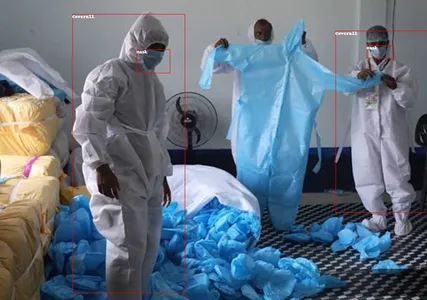Introduction
Generative artificial intelligence has gained sudden traction in the last few years. It is not surprising that there is becoming a strong attraction between healthcare and Generative artificial intelligence. Artificial Intelligence (AI) has rapidly transformed various industries, and the healthcare sector is no exception. One particular subset of AI, generative artificial intelligence, has emerged as a game-changer in healthcare.

Generative AI systems can generate new data, images, or even complete works of art. In healthcare, this technology holds immense promise for enhancing diagnostics, drug discovery, patient care, and medical research. This article explores the potential applications and benefits of generative artificial intelligence in healthcare and discusses its implementation challenges and ethical considerations.
Learning Objectives
- GenAI and its application in healthcare.
- The potential benefits of GenAI in healthcare.
- Challenges and limitations of implementing generative AI in healthcare.
- Future perspective trends in generative AI in healthcare.
This article was published as a part of the Data Science Blogathon.
Table of contents
Potential Applications of Generative Artificial Intelligence in Healthcare
Research has been done in several areas to see how GenAI can incorporate into healthcare. It has influenced the generation of molecular structures and compounds for drugs fostering the identification and discoveries of potential drug candidates. This could save time and also cost while leveraging cutting-edge technologies. Some of these potential applications include:
Enhancing Medical Imaging and Diagnostics
Medical imaging plays a crucial role in diagnosis and treatment planning. Generative AI algorithms, such as generative adversarial networks (GANs) and variational autoencoders (VAEs), have remarkably improved medical image analysis. These algorithms can generate synthetic medical images that resemble real patient data, aiding in the training and validation of machine-learning models. They can also augment limited datasets by generating additional samples, enhancing the accuracy and reliability of image-based diagnoses.

Facilitating Drug Discovery and Development
Discovering and developing new drugs is complex, time-consuming, and expensive. Generative AI can significantly expedite this process by generating virtual compounds and molecules with desired properties. Researchers can employ generative models to explore vast chemical space, enabling the identification of novel drug candidates. These models learn from existing datasets, including known drug structures and associated properties, to generate new molecules with desirable characteristics.
Personalized Medicine and Treatment
Generative AI has the potential to revolutionize personalized medicine by leveraging patient data to create tailored treatment plans. By analyzing vast amounts of patient information, including electronic health records, genetic profiles, and clinical outcomes, generative AI models can generate personalized treatment recommendations. These models can identify patterns, predict disease progression, and estimate patient responses to interventions, enabling healthcare providers to make informed decisions.
Medical Research and Knowledge Generation
Generative AI models can facilitate medical research by generating synthetic data that adheres to specific characteristics and constraints. Synthetic data can address privacy concerns associated with sharing sensitive patient information while allowing researchers to extract valuable insights and develop new hypotheses.

Generative AI can also generate synthetic patient cohorts for clinical trials, enabling researchers to simulate various scenarios and evaluate treatment efficacy before conducting costly and time-consuming trials on actual patients. This technology has the potential to accelerate medical research, drive innovation, and expand our understanding of complex diseases.
CASE STUDY: CPPE-5 Medical Personal Protective Equipment Dataset
CPPE-5 (Medical Personal Protective Equipment) is a new dataset on the Hugging Face platform. It presents a strong background to embark on GenAI in medicine. You could incorporate it into Computer Vision tasks by categorizing medical personal protective equipment. This also solves the problem with other popular data sets focusing on broad categories since it is streamlined for medical purposes. Utilizing this new medical dataset can prosper new GenAI models.
Features of the CPPE-5 dataset
- Approximately 4.6 bounding boxes annotations per image, making it a quality dataset.
- Original images taken from real life.
- Easy deployment to real-world environments.
How to Use CPPE-5 Medical Dataset?
It is hosted on Hugginface and can be used as follows:
We use Datasets to install the dataset
# Transformers installation
! pip install -q datasets Loading the CPPE-5 Dataset
# Import the necessary function to load datasets
from datasets import load_dataset # Load the "cppe-5" dataset using the load_dataset function
cppe5 = load_dataset("cppe-5") # Display information about the loaded dataset
cppe5Let us see a sample of this dataset.
# Access the first element of the "train" split in the "cppe-5" dataset
first_train_sample = cppe5["train"][0] # Display the contents of the first training sample
print(first_train_sample)
The above code displays a set of image fields. We can view the dataset better as shown below.
# Import necessary libraries
import numpy as np
import os
from PIL import Image, ImageDraw # Access the image and annotations from the first sample in the "train" split of the "cppe-5" dataset
image = cppe5["train"][0]["image"]
annotations = cppe5["train"][0]["objects"] # Create an ImageDraw object to draw on the image
draw = ImageDraw.Draw(image) # Get the categories (class labels) and create mappings between class indices and labels
categories = cppe5["train"].features["objects"].feature["category"].names
id2label = {index: x for index, x in enumerate(categories, start=0)}
label2id = {v: k for k, v in id2label.items()} # Iterate over the annotations and draw bounding boxes with class labels on the image
for i in range(len(annotations["id"])): box = annotations["bbox"][i - 1] class_idx = annotations["category"][i - 1] x, y, w, h = tuple(box) draw.rectangle((x, y, x + w, y + h), outline="red", width=1) draw.text((x, y), id2label[class_idx], fill="white") # Display the annotated image
image

With the availability of datasets like this, we can leverage developing Generative AI models for medical professionals and activities. Find a complete Github on CPPE-5 Medical Dataset here.
Training an Object Detection Model
Let us see an instance of manually training an object detection pipeline. Below we use a pre-trained AutoImageProcessor on the input image and an AutoModelForObjectDetection for object detection.
# Load the pre-trained AutoImageProcessor for image preprocessing
image_processor = AutoImageProcessor.from_pretrained("MariaK/detr-resnet-50_finetuned_cppe5") # Load the pre-trained AutoModelForObjectDetection for object detection
model = AutoModelForObjectDetection.from_pretrained("MariaK/detr-resnet-50_finetuned_cppe5") # Perform inference on the input image
with torch.no_grad(): # Preprocess the image using the image processor and convert it to PyTorch tensors inputs = image_processor(images=image, return_tensors="pt") # Forward pass through the model to obtain predictions outputs = model(**inputs) # Calculate target sizes (image dimensions) for post-processing target_sizes = torch.tensor([image.size[::-1]]) # Post-process the object detection outputs to obtain the results results = image_processor.post_process_object_detection(outputs, threshold=0.5, target_sizes=target_sizes)[0] # Iterate over the detected objects and print their details
for score, label, box in zip(results["scores"], results["labels"], results["boxes"]): # Round the box coordinates to 2 decimal places for better readability box = [round(i, 2) for i in box.tolist()] # Print the detection details print( f"Detected {model.config.id2label[label.item()]} with confidence " f"{round(score.item(), 3)} at location {box}" )Plotting Results
We will now add bounding boxes and labels to the detected objects in the input image:
# Create a drawing object to draw on the image
draw = ImageDraw.Draw(image) # Iterate over the detected objects and draw bounding boxes and labels
for score, label, box in zip(results["scores"], results["labels"], results["boxes"]): # Round the box coordinates to 2 decimal places for better readability box = [round(i, 2) for i in box.tolist()] # Extract the coordinates of the bounding box x, y, x2, y2 = tuple(box) # Draw a rectangle around the detected object with a red outline and width 1 draw.rectangle((x, y, x2, y2), outline="red", width=1) # Get the label corresponding to the detected object label_text = model.config.id2label[label.item()] # Draw the label text on the image with a white fill draw.text((x, y), label_text, fill="white") # Display the image with bounding boxes and labels
image.show()
Find a complete Github on CPPE-5 Medical Dataset here.
Challenges and Ethical Considerations
While generative AI holds immense promise, its implementation in healthcare must address several challenges and ethical considerations. Some of them include:
- Reliability and Accuracy: Ensuring the reliability and accuracy of generated outputs is crucial. Biases, errors, or uncertainties in the generative AI models can severely affect patient care and treatment decisions.
- Privacy and Data Security: This is a paramount concern in healthcare. Generative AI models trained on sensitive patient data must adhere to strict data protection regulations to safeguard patient privacy. Implementing anonymization techniques and adopting secure data-sharing frameworks are essential to maintaining patient trust and confidentiality.
- Ambiguity and Interpretability: the complexity of GenAI and the merging of healthcare creates the problem of lack of interpretability and explainability in generative AI models posing challenges in healthcare. Understanding how these models generate outputs and making their decision-making process transparent is critical to gain the trust of healthcare professionals and patients.
Future Perspectives and Emerging Trends in GenAI in Healthcare
As technology continues to advance, several key perspectives and emerging trends are shaping the future of generative AI in healthcare:

1. Enhanced Diagnostics and Precision Medicine: The future of generative AI in healthcare lies in its ability to enhance diagnostics and enable precision medicine. Advanced models can generate high-fidelity medical images, effectively detecting and characterizing diseases with unprecedented accuracy.
2. Collaborative AI and Human-AI Interaction: The future of generative AI in healthcare involves fostering collaborative environments where AI and healthcare professionals work together. Human-AI interaction will be crucial in leveraging the strengths of both humans and AI algorithms.
3. Integration with Big Data and Electronic Health Records (EHRs): Integrating generative AI with big data and electronic health records holds immense potential. With access to vast amounts of patient data, generative AI models can learn from diverse sources and generate valuable insights. Using EHRs and other healthcare data, generative AI can help identify patterns, predict outcomes, and optimize treatment strategies.
4. Multi-Modal Generative AI: Future trends in generative AI involve exploring multi-modal approaches. Instead of focusing on a single data modality, such as images or text, generative AI can integrate multiple modalities, including genetic data, clinical notes, imaging, and sensor data.
5. Continual Learning and Adaptive Systems: Generative AI systems must adapt and learn continually to keep pace with the rapidly evolving healthcare landscape. Adapting to new data, emerging diseases, and changing healthcare practices is crucial. Future generative AI models will likely incorporate continual learning techniques, enabling them to update their knowledge and generate more accurate and relevant outputs over time.
Conclusion
Generative artificial intelligence has the potential to revolutionize healthcare by enhancing diagnostics, expediting drug discovery, personalizing treatments, and facilitating medical research. By harnessing the power of generative AI, healthcare professionals can make more accurate diagnoses, discover new treatments, and provide personalized care to patients. However, careful attention must be given to the challenges and ethical considerations of implementing generative AI in healthcare. With continued research and development, generative AI has the potential to transform healthcare and improve patient outcomes in the years to come.
Key Takeaways
- Generative artificial intelligence (AI) has immense potential to transform healthcare by enhancing diagnostics, drug discovery, personalized medicine, and medical research.
- Generative AI algorithms can generate synthetic medical images that aid in training and validating machine learning models, improving accuracy and reliability in medical imaging and diagnostics.
- Generative AI models can facilitate medical research by generating synthetic data that adheres to specific characteristics, addressing privacy concerns, and enabling researchers to develop new hypotheses and simulate clinical trials.
Frequently Asked Questions (FAQs)
A. Generative AI refers to a subset of artificial intelligence that focuses on creating new data or content rather than analyzing or predicting existing data utilizing algorithms, such as GANs and VAEs, to generate new outputs that resemble real data.
A. It can enhance medical imaging and diagnostics by generating synthetic images to train and validate machine-learning models. It can accelerate drug discovery by generating virtual compounds and molecules with desired properties and enable personalized medicine.
A. The reliability of generative AI-generated outputs depends on the quality and accuracy of the underlying models and the data they are trained on. Robust validation processes ensure the generated diagnoses and treatment plans align with clinical expertise and standards.
A. Since patient privacy is a significant concern in healthcare, GenAI models trained on sensitive patient data adhere to strict data protection regulations by implementing anonymization techniques and secure data-sharing frameworks such as synthetic data generation.
A. Generative AI is not intended to replace healthcare professionals. It is only designed to support and augment their expertise.
Reference Links
The media shown in this article is not owned by Analytics Vidhya and is used at the Author’s discretion.
Related
- SEO Powered Content & PR Distribution. Get Amplified Today.
- PlatoData.Network Vertical Generative Ai. Empower Yourself. Access Here.
- PlatoAiStream. Web3 Intelligence. Knowledge Amplified. Access Here.
- PlatoESG. Automotive / EVs, Carbon, CleanTech, Energy, Environment, Solar, Waste Management. Access Here.
- BlockOffsets. Modernizing Environmental Offset Ownership. Access Here.
- Source: https://www.analyticsvidhya.com/blog/2023/08/generative-ai-in-healthcare/



